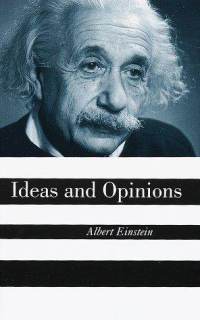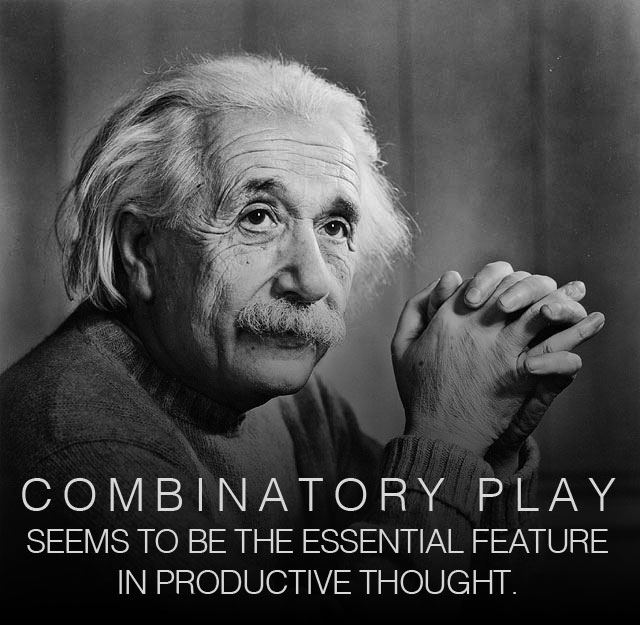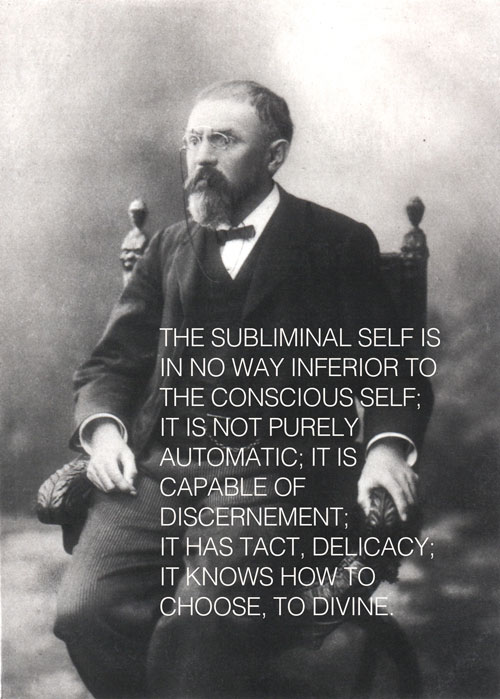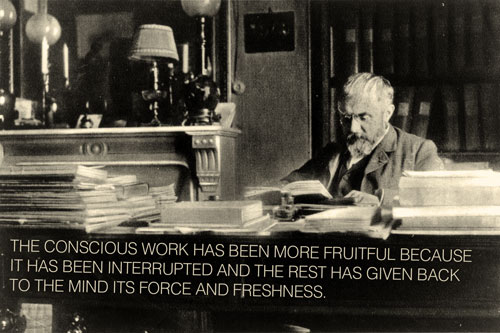How Einstein Thought: Fostering Combinatorial Creativity and Unconscious Connections
by Maria Popova
“Combinatory play seems to be the essential feature in productive thought.”
 For as long as I can remember — and certainly long before I had the term for it — I’ve believed that creativity is combinatorial: Alive and awake to the world, we amass a collection of cross-disciplinary building blocks — knowledge, memories, bits of information, sparks of inspiration, and other existing ideas — that we then combine and recombine,mostly unconsciously, into something “new.” From this vast and cross-disciplinary metal pool of resources beckons the infrastructure of what we call our “own” “original” ideas. The notion, of course, is not new — some of history’s greatest minds across art, science, poetry, and cinema have articulated it, directly or indirectly, in one form or another: Arthur Koestler’s famous theory of “bisociation” explained creativity through the combination of elements that don’t ordinarily belong together; graphic designer Paula Scher likens creativity to a slot machine that aligns the seemingly random jumble of stuff in our heads into a suddenly miraculous combination; T. S. Eliot believed that the poet’s mind incubates fragmentary thoughts into beautiful ideas; the great Stephen Jay Gould maintained that connecting the seemingly unconnected is the secret of genius; Gutenberg’s invention of the printing press embodied this combinatorial creativity; even what we call “intuition” is based on the unconscious application of this very mental faculty.
For as long as I can remember — and certainly long before I had the term for it — I’ve believed that creativity is combinatorial: Alive and awake to the world, we amass a collection of cross-disciplinary building blocks — knowledge, memories, bits of information, sparks of inspiration, and other existing ideas — that we then combine and recombine,mostly unconsciously, into something “new.” From this vast and cross-disciplinary metal pool of resources beckons the infrastructure of what we call our “own” “original” ideas. The notion, of course, is not new — some of history’s greatest minds across art, science, poetry, and cinema have articulated it, directly or indirectly, in one form or another: Arthur Koestler’s famous theory of “bisociation” explained creativity through the combination of elements that don’t ordinarily belong together; graphic designer Paula Scher likens creativity to a slot machine that aligns the seemingly random jumble of stuff in our heads into a suddenly miraculous combination; T. S. Eliot believed that the poet’s mind incubates fragmentary thoughts into beautiful ideas; the great Stephen Jay Gould maintained that connecting the seemingly unconnected is the secret of genius; Gutenberg’s invention of the printing press embodied this combinatorial creativity; even what we call “intuition” is based on the unconscious application of this very mental faculty.
The concept, in fact, was perhaps best explained by Albert Einstein, who termed it “combinatory play.” (Einstein famously came up with some of his best scientific ideas during his violin breaks.) From his Ideas and Opinions(public library) — the same invaluable volume that gave us the beloved physicist’s timeless wisdom on kindness and our shared existence — comes Einstein’s single most succinct articulation of how his mind works, driven by this powerful combinatorial creativity. The 1945 letter was written in response to French mathematician Jacques S. Hadamard’s survey of the mental processes of famous scientists, inspired by polymath Henri Poincaré’s famous meditation on the subject and published as An Essay on the Psychology of Invention in the Mathematical Field, with Einstein’s missive included as a “testimonial”:
My Dear Colleague:In the following, I am trying to answer in brief your questions as well as I am able. I am not satisfied myself with those answers and I am willing to answer more questions if you believe this could be of any advantage for the very interesting and difficult work you have undertaken.(A) The words or the language, as they are written or spoken, do not seem to play any role in my mechanism of thought. The psychical entities which seem to serve as elements in thought are certain signs and more or less clear images which can be “voluntarily” reproduced and combined.There is, of course, a certain connection between those elements and relevant logical concepts. It is also clear that the desire to arrive finally at logically connected concepts is the emotional basis of this rather vague play with the above-mentioned elements. But taken from a psychological viewpoint, this combinatory play seems to be the essential feature in productive thought — before there is any connection with logical construction in words or other kinds of signs which can be communicated to others.(B) The above-mentioned elements are, in my case, of visual and some of muscular type. Conventional words or other signs have to be sought for laboriously only in a secondary stage, when the mentioned associative play is sufficiently established and can be reproduced at will.(C) According to what has been said, the play with the mentioned elements is aimed to be analogous to certain logical connections one is searching for.(D) Visual and motor. In a stage when words intervene at all, they are, in my case, purely auditive, but they interfere only in a secondary stage, as already mentioned.(E) It seems to me that what you call full consciousness is a limit case which can never be fully accomplished. This seems to me connected with the fact called the narrowness of consciousness (Enge des Bewusstseins)
Ideas and Opinions is superb from cover to cover, the kind of book you return to again and again, only to find new layers of meaning with each reading. Complement it with this vintage technique for producing ideas and Einstein on the secret of learning anything.
 In his fantastic 1939 Technique for Producing Ideas, James Webb Young extolled “unconscious processing” — a period marked by “no effort of a direct nature” toward the objective of your creative pursuit — as the essential fourth step of his five-step outline of the creative process. The idea dates back to William James, who coined the concept of fringe consciousness. T. S. Eliot called this mystical yet vital part of creativity “idea incubation,” which Malcolm Cowley echoed in the second stage of his anatomy of the writing process. John Cleese similarly stressed the importance of time in creative work.
In his fantastic 1939 Technique for Producing Ideas, James Webb Young extolled “unconscious processing” — a period marked by “no effort of a direct nature” toward the objective of your creative pursuit — as the essential fourth step of his five-step outline of the creative process. The idea dates back to William James, who coined the concept of fringe consciousness. T. S. Eliot called this mystical yet vital part of creativity “idea incubation,” which Malcolm Cowley echoed in the second stage of his anatomy of the writing process. John Cleese similarly stressed the importance of time in creative work.
French Polymath Henri Poincaré on How Creativity Works
by Maria Popova
How to spark the “sudden illumination” of creative genius.
 In his fantastic 1939 Technique for Producing Ideas, James Webb Young extolled “unconscious processing” — a period marked by “no effort of a direct nature” toward the objective of your creative pursuit — as the essential fourth step of his five-step outline of the creative process. The idea dates back to William James, who coined the concept of fringe consciousness. T. S. Eliot called this mystical yet vital part of creativity “idea incubation,” which Malcolm Cowley echoed in the second stage of his anatomy of the writing process. John Cleese similarly stressed the importance of time in creative work.
In his fantastic 1939 Technique for Producing Ideas, James Webb Young extolled “unconscious processing” — a period marked by “no effort of a direct nature” toward the objective of your creative pursuit — as the essential fourth step of his five-step outline of the creative process. The idea dates back to William James, who coined the concept of fringe consciousness. T. S. Eliot called this mystical yet vital part of creativity “idea incubation,” which Malcolm Cowley echoed in the second stage of his anatomy of the writing process. John Cleese similarly stressed the importance of time in creative work.
From French polymath and pioneering mathematicianHenri Poincaré — whose famous words on the nature of invention inspired the survey that gave us a glimpse of how Einstein’s genius works — comes a fascinating testament to the powerful role of this unconscious incubation in the creative process. In a chapter titled “Mathematical Creation” from his 1904 tome The Foundations of Science: Science and Hypothesis, the Value of Science, Science and Method (public library; free download), Poincaré observes a process profoundly applicable not only to mathematics, but to just about any creative discipline:
I wanted to represent these functions by the quotient of two series; this idea was perfectly conscious and deliberate; the analogy with elliptic functions guided me. I asked myself what properties these series must have if they existed, and succeeded without difficulty in forming the series I have called thetafuchsian.Just at this time, I left Caen, where I was living, to go on a geologic excursion under the auspices of the School of Mines. The incidents of the travel made me forget my mathematical work. Having reached Coutances, we entered an omnibus to go some place or other. At the moment when I put my foot on the step, the idea came to me, without anything in my former thoughts seeming to have paved the way for it, that the transformations I had used to define the Fuchsian functions were identical with those of non-Euclidian geometry. I did not verify the idea; I should not have had time, as, upon taking my seat in the omnibus, I went on with a conversation already commenced, but I felt a perfect certainty. On my return to Caen, for conscience’ sake, I verified the result at my leisure.
With a true scientist’s insistence on empirical evidence, Poincaré ensures this was a pattern rather than mere one-off coincidence by citing another example of the process at work:
I turned my attention to the study of some arithmetical questions apparently without much success and without a suspicion of any connection with my preceding researches. Disgusted with my failure, I went to spend a few days at the seaside and thought of something else. One morning, walking on the bluff, the idea came to me, with just the same characteristics of brevity, suddenness and immediate certainty, that the arithmetic transformations of indefinite ternary quadratic forms were identical with those of non-Euclidian geometry.
He puts forth a notion contemporary researchers on creative productivity have since affirmed and speaks to the value of what we too tragically term “procrastination,” which is in fact a valuable part of ideation:
Most striking at first is this appearance of sudden illumination, a manifest sign of long, unconscious prior work. The role of this unconscious work in mathematical invention appears to me incontestable, and traces of it would be found in other cases where it is less evident. Often when one works at a hard question, nothing good is accomplished at the first attack. Then one takes a rest, longer or shorter, and sits down anew to the work. During the first half-hour, as before, nothing is found, and then all of a sudden the decisive idea presents itself to the mind. It might be said that the conscious work has been more fruitful because it has been interrupted and the rest has given back to the mind its force and freshness.
What’s more, Poincaré observes, not only circumstances but also substances help prime the mind for such moments of “sudden illumination”:
One evening, contrary to my custom, I drank black coffee and could not sleep. Ideas rose in crowds; I felt them collide until pairs interlocked, so to speak, making a stable combination. It seems, in such cases, that one is present at his own unconscious work, made partially perceptible to the over-excited consciousness, yet without having changed its nature. Then we vaguely comprehend what distinguishes the two mechanisms or, if you wish, the working methods of the two egos.
Still, Poincaré is careful to point out that without a foundation of prior conscious work — something Alexander Flexner touched on in his timeless meditation on the usefulness of useless knowledge — these “sudden illuminations” wouldn’t take place:
There is another remark to be made about the conditions of this unconscious work: it is possible, and of a certainty it is only fruitful, if it is on the one hand preceded and on the other hand followed by a period of conscious work. These sudden inspirations (and the examples already cited sufficiently prove this) never happen except after some days of voluntary effort which has appeared absolutely fruitless and whence nothing good seems to have come, where the way taken seems totally astray. These efforts then have not been as sterile as one thinks; they have set agoing the unconscious machine and without them it would not have moved and would have produced nothing.
He concludes:
The subliminal self is in no way inferior to the conscious self; it is not purely automatic; it is capable of discernment; it has tact, delicacy; it knows how to choose, to divine. What do I say? It knows better how to divine than the conscious self, since it succeeds where that has failed.
It appears, then, that in order for us to lubricate the machinery of unconscious ideation, we have to first prime the mind with directed conscious work, then relieve it of its standard inhibitions, whether by a distracting situation like a trip or a vacation, or by a stimulating substance like caffeine. (Curoiusly, more than a century after Poincaré’s remarks, scientists are beginning to suspect caffeine has the opposite effect and cramps creativity by making us too focused.)
Complement Poincaré’s insights from The Foundations of Science with Young’s indispensable 5-step “technique” for ideation and this excellent contemporary field guide to creativity.



Play!
ReplyDeleteWhen the solution is simple, God is answering. - Einstein
And we mortals make things so complicated :-)
ReplyDeleteAs spiritual just "being(s)" in an infinite universe ...everything already exists. Choosing to believe otherwise and the illusions of the world of mortals by choice is decidedly complex.
ReplyDelete